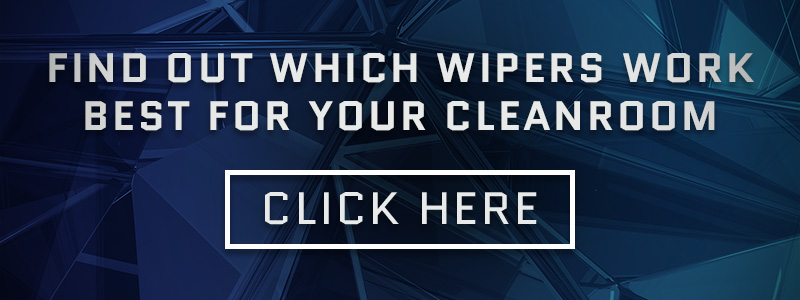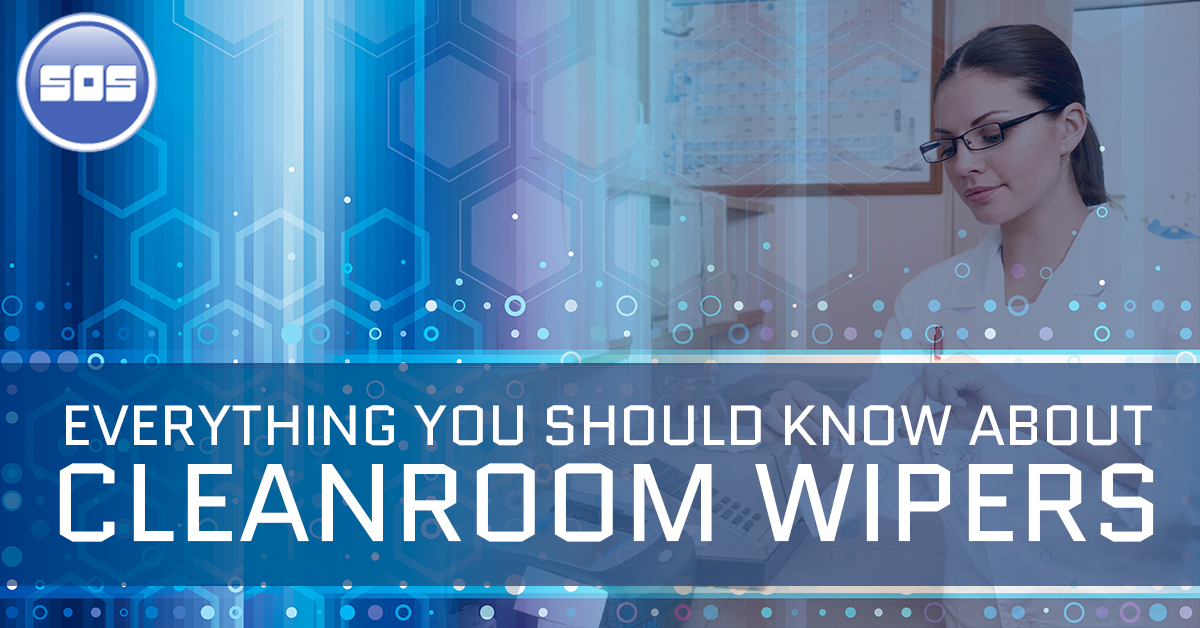
If you work in a cleanroom, you already know how important it is to maintain a cleanly environment. Whether you work in pharmaceuticals or semiconductor engineering, you should know that a cleanroom is a sensitive environment that must be monitored for pollutants and harmful airborne debris. Pollutants can be found naturally in the air and can come in the form of dust, microbes, particles, and more.
When spills and contamination occur, it’s important to ensure that your cleanroom staff has wipers on-hand for the most effective and convenient cleaning possible. Cleanroom environments are classified by the number of particles (sized .5 micrometers or larger) allowed per cubic meter of space. For example, in order to be classified at ISO 6, a room must have 35,200 particles or less per square meter. An ISO 4 cleanroom, on the other hand, can only have 352 particles.
In order for a cleanroom to sustain its appropriate cleanroom classification, employees who work in them must follow stringent procedures on a day-to-day basis. From employee attire to specialized cleaning techniques, cleanroom personnel must follow protocols to ensure contamination control.

How Are Cleanroom Wipers Different From Ordinary Wipers?
While you may think that you can use just any wiper to absorb spills in your cleanroom, this is often not the case. Cleanroom wipers are different from ordinary wipers because they feature lower levels of lint to protect against contaminants. They also boast higher levels of absorbency, resistance to chemicals and abrasion, and most of the time, better cleaning capabilities. Cleanroom wipers also tend to be very soft, making them great for cleaning sensitive equipment. These wipers are ideal for disinfecting surfaces while also ensuring sterilization by reducing the amount of endotoxins in the environment.
Similar to cleanrooms themselves, cleanroom wipers have different classifications that should be used in corresponding cleanrooms. For example, most cleanroom wipers are compatible with ISO class of 6 or higher.
Understanding Cleanroom Wipe Materials
Did you know that a variety of factors, including material, can influence the cleanliness and effectiveness of a cleanroom wipe? Most wipes will undergo numerous steps to determine its cleanroom compatibility range. Some of the most common cleanroom wipes are made of:
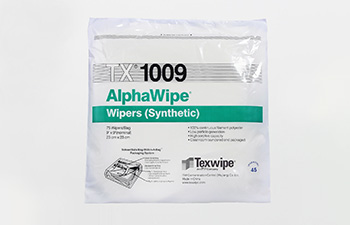
- Polyester - If you’re in the market for cleanroom wipes that offer durability and exceptional cleanliness, you should consider ordering polyester wipers for your cleanroom. The edges of these wipes can be melted to prevent loose ends and additional linting. Polyester wipes can be presaturated with a variety of solvents before they are sterilized and cut to size. These are most commonly found in ISO 3-4+ or Class 1-10 cleanrooms.
- Polyester & Cellulose Blends - Also called nonwoven wipes, polyester and cellulose blends are an absorbent and economic choice. Similar to polyester wipes, they can be presaturated with solvents before they are sterilized and cut to size. These wipes are common for ISO 5-7+ or Class 100-10,000 cleanrooms.
- Knit Polyester - Knit polyester cleanroom wipes are made with 100% continuous filament knit polyester and are sometimes called woven wipes because of how they are constructed. These wipes offer low particle release, and they can come in single knit, lightweight material, or double knit heavy weight material. Polyester is known to absorb solvents well.
- Cotton - Another woven wipe to consider for your cleanroom, cotton wipes are extremely durable and absorbent. You can also use these wipes with high heat tolerances. A downside to this material is that it tends to break down, which can result in lint, making it unsuitable for critical applications. Cotton wipes do, however, offer the highest in particulate release, making them a great choice for cleanrooms with less restrictive air particulate requirements.
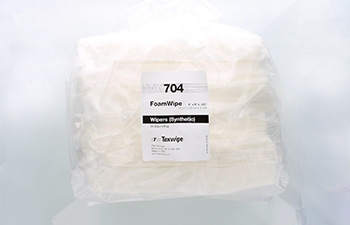
- Foam or Sponge - Foam or sponge cleanroom wipes are made from open-cell polyurethane foam. As a lint-free option, this wipe can absorb and release solvents, contaminants, and other liquid solutions. Foam wipes are ideal for cleaning spills and reducing contamination in Class 100+ cleanrooms.
- Nylon - Nylon cleanroom wipes are knitted with a unique stitch to assist with abrasion resistance. These wipes are great for contamination control and they offer exceptional softness and superior strength.
Shop for wipers by material from SOSCleanRoom today!

The Best Brands For Cleanroom Wipes
Texwipe
Texwipe is among the top brands to consider when it comes to cleanroom wipes. As a market leader in contamination control, and with more than 50 years of experience, Texwipe is one of the most recognized brands in the pharmaceutical and medical industries. They offer a wide variety of cleanroom wipes including dry wipes, pre-wetted wipes, non-sterile and sterile wipes, and pre-saturated wipes.
At SOSCleanRoom, we carry an extensive selection of Texwipe wipers that meet the strict requirements of pharmaceutical, biomedical, healthcare, food, and automotive industries. Some of our most popular Texwipe wipes include:
STX1034 Sterile AlphaSat 4" x 4" Polyester Cleanroom Wiper
The AlphaSat Polyester Cleanroom Wiper is made from 100% continuous-filament polyester in a double-knit, no-run interlock pattern. These wipes are custom laundered and packaged, making them ideal for cleaning critical environments. Featuring a laundered cut edge, these wipes exhibit low particle and fiber levels with a 10-6 Sterility Assurance Level.
TX3280 Sterile AlphaSat 10 12" x 12" Polyester Wiper
The TX3280 Sterile AlphaSat 10 polyester wipes can be used to clean any critical sterile environment in pharmaceutical aseptic fill areas, biotechnology manufacturing facilities, and prep rooms. These wipes are pre-wetted with 70% USP Isopropyl Alcohol (IPA) and 30% Water for Injection (WFI) in a resealable, flat package. You can also use these wipes to clean production equipment and environmental surfaces.
Vertex®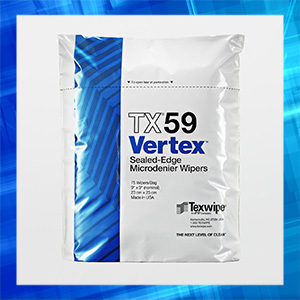
With more than four decades of innovation in cleanroom wipers, Vertex has set a new standard of contamination control for the medical, pharmaceutical, and biotech industries. With the help of their HandsFree™ system, Vertex isolates the wiper material from human contact. This allows the wipers to be cleaned, sealed, inspected, and packed without any human intervention.
TX22 Vertex 12" x 12" Polyester High Durability Laser Edge Cleanroom Wiper
The TX22 Vertex Polyester Cleanroom Wiper is made from 100% polyester with double-knit wipers that are designed for incredible sorption capacity with maximum abrasion resistance. Ideal for use on sharp edges and made in the USA, all Vertex wipes are manufactured in an ISO Class 3 environment.
TX59 Vertex 9" x 9" Microdenier Sealed Edge Cleanroom Wiper
The TX59 Vertex Sealed Edge Cleanroom Wiper is made from 100% polyester, featuring four times the number of filaments and twice the surface area compared to standard polyester wipes. This increases wiping efficiency and creates a soft hand, which is a unique characteristic of this microdenier wiper. Ideal for wiping surface that are susceptible to scratching, this wiper can help you capture microbial contamination in your cleanroom.
TechniSat®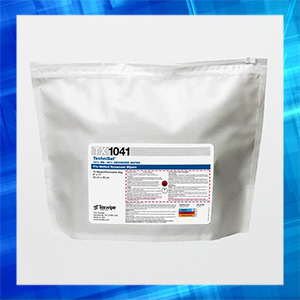
TechniSat offers some of the best cleanroom wipes on the market. Their wipes incorporate a pre-wetted fabric blend of nonwoven hydroentangled cellulose (55%) and polyester (45%). With highly absorbent properties, these wipers offer a low particle count.
TX1041 TechniSat 9" x 11" Cellulose/Polyester Cleanroom Wiper
Shopping for cleanroom wipes for your laboratory or pharmaceutical operation? Order the TX1041 TechniSat cellulose and polyester cleanroom wiper today. Packaged in a convenient and resealable dispenser, these wipes will deliver a premeasured amount of high-purity alcohol to any surface you need to clean. Ideal for wiping down lab equipment and environmental cleanroom surfaces, you’ll love what these wipes have to offer.
TX8488 TechniSat 9" x 11" Cellulose/Polyester Cleanroom Wiper
The TX8488 TechniSat 9" x 11" Cellulose/Polyester Cleanroom Wiper combines the highly absorbent properties of a natural fiber with the cleanliness and durability of synthetic fibers. These wipers are perfect for rapid wipedowns, and they offer low particle generation and low levels of solvent extractables.

Industries That May Require Cleanroom Wipes
Biotechnology and Pharmaceutical Cleanrooms
Most biotechnology and pharmaceutical cleanrooms are specified at ISO Class 5 to ISO Class 8. Particulate is a main concern in these spaces, and there are a variety of ways that you can keep your cleanroom free of contaminants. Many of these cleanrooms will require personnel to wear cleanroom garments to keep particles out of the space.
At SOSCleanRoom, we offer a wonderful selection of cleanroom garments that can help to keep your biotech or pharmaceutical cleanrooms pristine. From aprons to hoods and shoe covers to gowns, we’ve got all of the cleanroom supplies you need.
The Aerospace Industry
The aerospace industry uses cleanrooms to perform experiments, as well as creating items like space-flight lasers and spaceships. Creating aerospace tools requires a controlled environment, otherwise the product at hand may be compromised by contaminants and pollutants.
Optic Facilities
While you probably love the camera on your smartphone, did you know that its photo lens was probably manufactured in a cleanroom? The process of lens manufacturing requires strict particulate contamination controls, along with humidity and temperature control. Thanks to the steps taken by cleanroom employees, we have a way to capture some of the best moments of our life from our cell phones.
Nanotechnology and Electronics
From your laptop to your bluetooth speaker, the chips and nanochips that go into these technological devices are incredibly small. While these pieces of technology are small, they hold and store a ton of critical data, and each device must be 100% accurate in order for the rest of the machine to work. Even the smallest speck of dust in the wrong place can render a computer, tablet, or gaming device ineffective, which is why it’s so important that these items are manufactured in a controlled cleanroom.
Research Facilities
Research facilities utilize cleanrooms and cleanroom supplies on a daily basis. Whether they are located on a college campus or at a pharmaceutical company, it’s important that these environments are free of airborne contaminants and debris. This allows scientists to run experiments and tests while being absolutely sure that outside variables stay consistent. Cleanrooms are used to help researchers reduce cross-contamination or other variables that might impede accurate test results.

Cleanroom Classifications

There are a variety of factors involved when it comes to determining cleanroom classification, and every industry has its own default standard to start with. A cleanroom is a space that is specifically designed to keep the outside environment from getting in. Once a cleanroom space has been constructed, there are two things that can lead to contamination: the people and the process.
There are three main questions to ask yourself in order to determine what classification your cleanroom application should be, including:
- What are the main sources of contamination in my cleanroom?
- What size particles do I need to filter out?
- How much air do I have to circulate in my cleanroom to help get contaminants out?
How Does Particle Size Impact Classifications?
If you’re wondering how particle size impacts cleanroom classifications, we’re here to catch you up to speed. As we mentioned above, one of the first questions to ask yourself is, what size particle do I need to filter out?
In the cleanroom environment, air particles are measured in microns. One micron is equal to one-millionth of a meter. Most of the time, micron-sized particles are smaller than a living cell and can only be seen with state-of-the-art microscopes. To put this into better perspective, consider the bullet below.
- One strand of human hair can vary in width from approximately 20 to 180 microns.
- A small dust particle that can be seen in a ray of sun equates to roughly 60 microns.
- The human eye cannot consistently see objects or particles less than 50 microns in size.
- Pollen is often between 30 to 50 microns.
- Bacteria can be between 2 to 10 microns in size.
In order to properly maintain a cleanroom or controlled environment, it’s imperative that you have the products and tools designed to keep unwanted contaminants out of your space. When an employee accidentally spills a chemical, there should be cleanroom wipers within reach to ensure the sterilization of various surfaces. Before we dive into the nitty gritty of why you should have cleanroom wipers in your facility, it may be beneficial to discuss cleanrooms a bit further.
Cleanrooms are used in a variety of industries including pharmaceuticals and semiconductor engineering. A cleanroom can be defined as a sensitive environment in which the number of pollutants must be carefully monitored and kept to a minimum. What are pollutants, you ask? Pollutants can be a variety of things such as dust, air particles, microbes, and debris. When it comes to making things like computer components and optical supplies, a cleanroom is necessary.
In order to maintain the cleanliness of a cleanroom, it’s important that employees who work in these environments follow stringent rules. Whether it’s stepping on a sticky mat every time they enter a cleanroom, wiping down countertops after a specific application, or wearing the appropriate cleanroom garments, there are many things that can be done to reduce the number of pollutants in a cleanroom.
Cleanrooms are classified by the number of contaminstants that exist in its space. Contamination is measured in parts per cubic meter. For example, many electronics manufacturing cleanrooms are classified as ISO Class 6. This level is rated at 35,200 parts per cubic centimeter. What does this mean, exactly? It means that if you’re in that particular class 6 cleanroom, you shouldn’t have more than 35,200 particles greater than .5 microns in size (per cubic centimeter of the space).
What Makes A Cleanroom Wiper A Cleanroom Wiper?
You may be wondering what makes a cleanroom wiper different from other wipes on the market. This is a very good question. Most cleanroom wipes feature much lower levels of lint in order to protect against contaminants. They also offer better levels of absorbency, making them great for cleaning up spills. Cleanroom wipes are also created to be chemical resistance and abrasion resistant, making them ideal for wiping down laboratory countertops and equipment. Similar to cleanrooms, cleanroom wipers are identified by different classifications.
Wet vs. Dry Cleanroom Wipes
If you’re wondering what the difference is between wet cleanroom wipes and dry cleanroom wipes, the professionals at SOS Cleanroom are here to clear things up. Wet cleanroom wipers are known for their ability to trap particles, which results in better surface contact. The amount of fluid on a wet wiper is critical to its success because if it is too wet, the particles and debris may be re-deposited on the surface instead of picked up into the wipe. The dry cleanroom wipers, on the other hand, can be used to capture and retain particles from the surface. Cleanroom wipes are prefered over regular wipes because they are extremely convenient to use when compared to other methods of cleaning.

Things To Consider When Choosing Cleanroom Wipers
Questions To Ask Yourself
Cleanroom wipers come in a variety of types, and depending on your unique application, one wiper may be better than the next. There are a few questions you should ask yourself before buying cleanroom wipers for your facility, including:
- Do I want a cleanroom wiper for dry or wet cleaning?
- Am I looking for a wipe that is resistant to chemicals?
- What classification of cleanroom wipe will work best in my facility?
Surface Material
Depending on the application of your cleanroom, it’s important to pay attention to each surface you plan on wiping down. Different cleanroom wipers may be more effective on different types of surface material, and since the surface material in cleanroom can vary, it’s something to be aware of. Cleanroom surfaces come in a variety of materials including rubber, glass, plastic, and more.
Cleanroom Wiper Material
There are several different kinds of cleanroom wipers on the market made from various materials. The most popular wiper materials are listed below.
- Polyester
- Cellulose
- Polyester/Cellulose Blend
- Cotton
- Nylon
- Polypropylene
- Micro Fiber
- Foam
At SOS Cleanroom, we’re proud to offer a large selection of polyester, cellulose, and nylon cleanroom wipers. Be sure to browse our website for the best cleanroom wipes today!

The Top Cleanroom Supply Brands
As you start shopping for wipers for your cleanroom, it’s always wise to do your research on the various brands on the market. Some cleanroom wiper brands only make wet wipers while others focus on creating wipers for the healthcare industry. We’ve compiled a list of some of the top wiper brands and cleanroom supply brands to make your life a little bit easier.
ITW Texwipe
ITW Texwipe is a worldwide leader in contamination control supplies including cleanroom wipers, cleanroom swabs, adhesive mats, and more. Based out of Kernersville, North Carolina, the company is committed to providing top technology, innovation, and service excellence in all of the products that they offer. Whether you work in the aerospace, aviation, food processing, or medical industry, ITW Texwipe has the cleanroom products you need to keep unwanted contaminants at bay.
Chemtronics
The mission of Chemtronics is to continue as the industry’s innovative technology leader by providing its customers with the tools they need to achieve the highest degree of reliability and productivity. As a leader in cleanroom supplies for the electronics and telecommunications market, the company offers a wonderful selection of cleanroom wipers, contact cleaners, and degreasers.
Static Solutions
Headquartered in Hudson, Massachusetts, Static Solutions is a leading manufacturer of static control, cleanroom and maintenance products. The company is committed to the innovation of ESD products, and with over two decades of experience, they offer amazing cleanroom solutions for their customers.
SOSCleanroom.com is proud to be an industry leader in the distribution of cleanroom supplies used in commercial, medical, and industrial applications. Visit our website to shop for cleanroom wipers, swabs, garments, sticky mats, ESD equipment, and more!
SOSCleanRoom: Your Online Cleanroom Supply Store
SOSCleanRoom.com is proud to be an industry leader in the distribution of cleanroom supplies used in commercial, medical, and industrial applications. For more than 33 years, we’ve been providing best-in-class service to our customers involved in a variety of industries including electronics manufacturing, pharmaceutical, healthcare, aerospace, and more. We carry a large and diverse collection of cleanroom products including wipers, swabs, sticky mats, cleanroom garments, gloves, alcohol, and more. If you have any questions about our cleanroom supplies, feel free to reach out to our friendly staff today!


